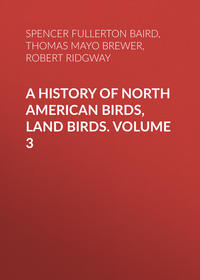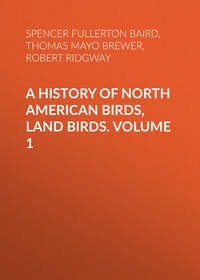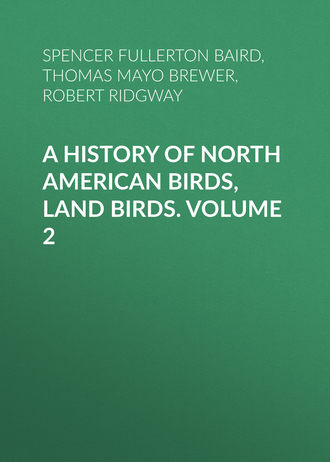 полная версия
полная версияПолная версия
A History of North American Birds, Land Birds. Volume 2
These birds, he states, arrive in Louisiana from the South about the middle of April, and build early in May. They reach Savannah about the 20th of April. Their nests are usually fixed in orange hedges or in the lower branches of the trees. He often found them in common bramble and blackberry bushes. They are formed exteriorly of dry grass intermingled with the silk of caterpillars, with hair and fine rootlets. Some nests had eggs as late as the 25th of June, which were probably a second brood. The food of this bird consists of rice, insects, and various kinds of seeds. They also feed on the seeds of ripe figs.
A single specimen of this species was detected by Mr. Ridgway in Southern Illinois between Olney and Mount Carmel, on the 10th of June. It is therefore presumed to be a rare summer resident in that locality.
The Nonpareil is possessed of a very pugnacious disposition, and, according to Mr. Audubon, the bird-dealers of New Orleans take advantage of this peculiarity in a very ingenious manner to trap them. A male bird is stuffed and set up in an attitude of defence on the platform of a trap-cage. The first male bird of this species that notices it is sure to make an attack upon it, and is at once trapped. So pertinacious are they that even when thus imprisoned the captive repeats its attack upon its supposed rival. They feed almost immediately upon being caught, and usually thrive in confinement, Audubon mentioning one that had been caged for ten years.
This bird is very easily made to breed in confinement. Dr. Bachman has had a single pair thus raise three broods in a season.
The eggs of this species measure .80 by .65 of an inch, and do not at all resemble the eggs of the cyanea or amœna. They have a dull or pearly-white ground, and are very characteristically marked with blotches and dots of purplish and reddish brown.
Genus SPERMOPHILA, SwainsonSpermophila, Swainson, Zoöl. Jour. III, Nov. 1827, 348. (Type, Pyrrhula falcirostris, Temm. Sufficiently distinct from Spermophilus, F. Cuv. 1822.)
Sporophila, Cabanis, Mus. Hein. 1851, 148. (Type, Fringilla hypoleuca, Licht.)
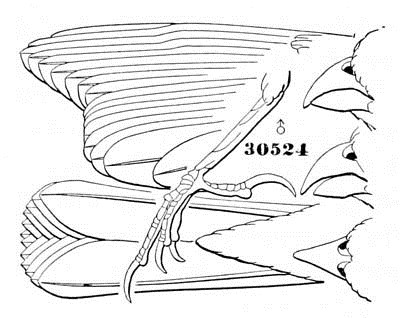
Spermophila moreleti.
30524 ♂
Gen. Char. Bill very short and very much curved, as in Pyrrhula, almost as deep as long; the commissure concave, abruptly bent towards the end. Tarsus about equal to middle toe; inner toe rather the longer (?), reaching about to the base of the middle one; hind toe to the middle of this claw. Wings short, reaching over the posterior third of the exposed part of the tail; the tertiaries gradually longer than the secondaries, neither much shorter than the primaries, which are graduated, and but little different in length, the first shorter than the sixth, the second and fourth equal. The tail is about as long as the wings, rounded, all the feathers slightly graduated, rather sharply acuminate and decidedly mucronate. Smallest of American passerine birds.
The essential characters of this genus are the small, very convex bill, as high as long; the short broad wings, with the quills differing little in length, the outer ones graduated; the tail as long as the wings, widened towards the end, and slightly graduated, with the acuminate and mucronate tip to the feathers.
Many species of the genus occur in Middle and South America, although none not readily distinguishable from the single North American one.
Spermophila moreleti, PucheranLITTLE SEED-EATERSpermophila moreleti, (Pucheran,) Bonap. Conspectus, 1850, 497.—Sclater, Pr. Zoöl. Soc. 1856, 302.—Baird, Birds N. Am. 1858, 506, pl. liv, f. 2, 3.—Ib. Mex. Bound. II, Birds, 17, pl. xvi, f. 2, 3. Sporophila moreleti, Cab. Mus. Hein. 1851, 150.—Ib. Journ. für. Orn. IX, 1861, 4 (with synonomy). Spermophila albigularis, (Spix,) Lawrence, Ann. N. Y. Lyceum, V, Sept. 1851, 124 (Texas. Not of Spix).
Sp. Char. The top and sides of the head, back of the neck, a broad band across the upper part of the breast extending all round, the middle of the back, the wings and tail, with the posterior upper coverts, black. The chin, upper throat and neck all round, but interrupted behind, the rump, with the remaining under and lateral portions of the body, white; the latter tinged with brownish-yellow. Two bands on the wing, across the greater and middle coverts, with the concealed bases of all the quills, also white. Length, about 4 inches; wing, 2.05; tail, 1.90.
Female. Dull yellow; olivaceous above, brownish-yellow beneath. Wings and tail somewhat as in the male.
Hab. Rio Grande of Texas; south to Costa Rica. Xalapa (Scl. 1859, 365); Oaxaca (Scl. 1859, 378); Cordova (Scl. 1856, 302); Guatemala (Scl. Ibis, I, 17; Salv. Ibis, I, 468; nest); Costa Rica (Cab. J. 1861, 4); Vera Cruz, winter, alpine region, breeding (Sum. M. B. S. I, 551).
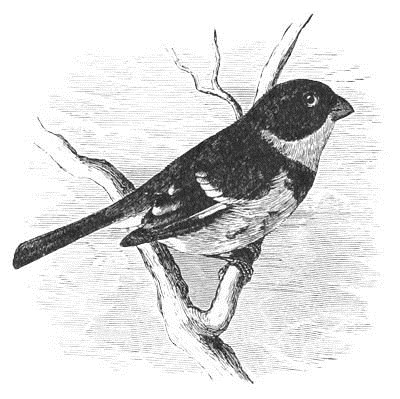
Spermophila moreleti.
The specimen upon which the preceding description of the male has been based is the only one in full plumage we have seen, and was kindly lent by Mr. P. L. Sclater. It was collected in Honduras. Some of the feathers of the back have grayish tips. The specimen described by Mr. Lawrence as S. albigularis, though male, is, in most respects, like the female, except that the wings and tail are darker, the color of the upper part grayer, and the interscapular feathers blotched with black. The black of the head is strongly indicated, the feathers, however, all with gray margins. In this and another, a little further advanced, from San Diego, Mexico, (4096,) there is a very faint indication of the black pectoral band, and there is no trace of the whitish of the rump.
Habits. This pretty little tropical form of Sparrow can only rest a claim to be included in our fauna by its occasional presence on the Rio Grande in Texas. It is found throughout Mexico and Central America.
Mr. Sumichrast found it throughout the State of Vera Cruz, except only in the elevated or alpine regions. Its common name was Frailecito. It was abundant throughout the hot and the temperate regions as well as the plateau.
This species was first met with near the Lake of Peten, in Guatemala, by M. Morelet, and was described from his specimens in the Paris Museum by Prince Bonaparte. Mr. Salvin found it a not uncommon species about Dueñas, where it is generally to be found amongst the tall weeds on the edge of the lake. It was also found at Belize. From a letter of Mr. Salvin, published in the Ibis of 1859 (p. 468), we quote the following in reference to the nest of this species, which is all the information we have in relation to this diminutive Sparrow: “A day or two ago I found two nests of Spermophila moreleti, and took one rotten dried-up egg from one with a young one in it. Nothing could be more different than this nest and that of S. bicolor, so well described by Mr. Newton. That of S. moreleti, instead of the loose domed structure of S. bicolor, with a large side-entrance, composed entirely of one material, is one of the neatest nests you ever saw,—a beautiful, open, transparent nest, composed of fine roots and fibres, and lined with horsehair. It is not placed resting on a branch, but is suspended like a Reed Warbler’s (Salicaria arundinacea), by several small twigs. The eggs, too, differ materially.” Mr. Salvin gives no description of these eggs.
This bird was found a resident during the winter months, and in May also, at Plaza Vicente, in the State of Oaxaca, Mexico. This is in the low or hot lands of that region.
Genus PHONIPARA, BonapPhonipara, Bonaparte, 1850. (Type, Loxia canora, Gm.)
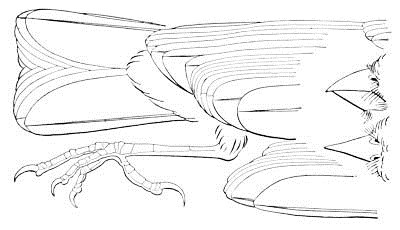
Phonipara zena.
Gen. Char. Size very small. Wing considerably longer than the tail, but much rounded; third or fourth quill longest; first about equal to seventh. Tail very slightly rounded, the feathers broad. Bill very short and deep, but the depth through the base less than the culmen; culmen but slightly, or not appreciably, curved; bill much compressed. Feet stout; tarsi longer than the middle toe; outer toe longer than the inner, its claw just reaching the base of the middle claw; hind toe with the claw very large, and strongly curved. Among the least of American Fringillidæ.
The introduction of this genus into the North American fauna is the result of Mr. Maynard’s indefatigable labors in the exploration of Florida. The species are principally West Indian, a single race alone belonging to the continental portion of Middle America.
Species and VarietiesCommon Characters. Sexes very different. Above olive-green, beneath blackish or whitish. ♂. Head and breast black, the former with or without yellow patches. ♀ with the yellow and black indicated only, or wanting. Length, about 4.00.
A. Head without any yellow.
1. P. zena. Culmen decidedly curved. Above dull grayish olive-green. ♂. Head and lower parts, especially anteriorly, dull black, mixed with whitish posteriorly. ♀. Head and beneath ashy. Wing, about 2.00; tail, 1.75. Hab. West Indies (Cuba, Hayti, Porto Rico, St. Bartholomew, Jamaica, etc.); also Key West, Florida (Maynard).
B. Head with yellow patches.
2. P. pusilla. Culmen perfectly straight. Above rather bright olive-green. ♂, a supraloral stripe, a patch on chin, and upper part of throat, with edge of wing, bright yellow; forehead, lores, and jugulum black. ♀ with the black and yellow only indicated, or wanting.
Whole crown, cheeks, breast, and upper part of abdomen black. Hab. Middle America, from Mirador to Panama, and southward … var. pusilla.12
Only isolated spots, covering forehead, lore, and base of lower jaw, and patch on jugulum, black. Hab. West Indies. (Porto Rico, Hayti, Jamaica, Cuba, etc.) … var. olivacea.13
3. P. canora.14 Culmen decidedly curved. Above bright olive-green; beneath pale ashy, whitish on anal region. A bright yellow broad crescent across the lower part of the throat, curving upward and forward, behind and over the auriculars, to above the eye. ♂. Lores, auriculars, and chin, and a band across the jugulum, black. ♀. Chin, etc., chestnut-brown; no black on jugulum. Hab. Cuba.
Phonipara zena, BryantTHE BLACK-FACED FINCHFringilla zena, Linn. Syst. Nat. I, (ed. 10,) 1758, 183 (based on Passer bicolor bahamensis, Catesby, Carol. I, tab. 37, Bahamas).—Bryant, Pr. Bost. Soc. N. H. X, 1865, 254. Fringilla bicolor, Linn. Syst. Nat. I, (ed. 12,) 1766, 324 (same original as zena). Spermophila bicolor, Gosse (Jamaica). Phonipara bicolor, Newton (St. Croix). ? Tiaris omissa, Jardine, Ann. Nat. Hist. 1847, 332 (Tobago). Phonipara omissa, Sclater. Phonipara marchi, Baird, Pr. A. N. Sc. Phila. Nov. 1863, 297 (Jamaica). Fringilla zena, var. marchi, Bryant, Pr. Bost. Soc. 1867, 43. Fringilla (Phonipara) zena, var. portoricensis, Bryant, Pr. Bost. Soc. X, 1865, 254 (Porto Rico).
Sp. Char. Male adult (627, Bryant coll.; Inagua). Above dull olive-green, the head and lower parts black, the two colors blending insensibly into each other; feathers of the middle of the abdomen and crissum edged with whitish. Wing, 2.10; tail, 1.80, culmen, .35; tarsus, .63; middle toe, .50.
Female adult (983, Bryant coll.; Inagua). Above dull olive-green, beneath ashy, whitish on the abdomen and crissum; no black. Wing, 2.10.
Male juv. (981, Bryant coll.; Inagua). Like the adult female, but the head anteriorly, the chin, throat, and jugulum medially, black. Wing, 2.05.
Hab. West Indies (Bahamas; Jamaica, Porto Rico; St. Croix, Tobago?).
Quite a large series of this species from the various West Indian Islands show a considerable variation in the amount of black in male birds; nothing characteristic of the different islands, however, for, in specimens from each, individuals are to be found agreeing in every respect with the stages described above.
Habits. The Black-faced Finch of Jamaica and other West India Islands claims a place in the fauna of the United States as an occasional visitant of Florida; of how common occurrence on that peninsula we cannot determine. It was taken there in the spring of 1871 by Mr. Maynard, and is possibly an accidental rather than a regular visitant. It is found in many of the West India Islands, though being resident in their several places of abode, they naturally exhibit certain characteristics as of distinct races. The eggs of the St. Croix bird differ considerably from those of the Jamaica one.
The Messrs. Newton, in their account of the birds of St. Croix, mention this bird as having a Bunting-like song, heard always very early in the morning. It is said to frequent the curing-houses, hopping on the uncovered sugar-hogsheads, and making a plentiful meal therefrom. It is very sociable, and feeds in small flocks, mostly on the ground among the guinea-grass. The crops of those dissected were usually found to contain small seeds. They build domed nests in low bushes, thickets of bamboo, or among creepers against the side of a house, seldom more than four feet from the ground, composed entirely of dry grass, the interior being lined with finer materials of the same. The opening is on one side, and is large for the size of the nest. They breed from the middle of May to the end of July. The eggs are white, spotted with red, especially at the larger end. The usual number of eggs is three, very rarely four. Their measurement is .65 by .50 of an inch.
In Jamaica Mr. March speaks of it as the most common of the Grass Finches, of which there are three other species, and as nesting at all seasons of the year in low trees and bushes. Near homesteads, in building their domed nests, they make use of shreds, scraps of cloth, bits of cotton, and other trash. Their eggs, he says, are three and sometimes even six in number; and he mentions their varying both as to dimensions and coloring, which may explain the difference between the eggs from St. Croix and Jamaica. Those from the latter place measure .72 by .50 of an inch, and the markings are more of a brown than a red color.
Mr. Hill adds that the Grass Finch very frequently selects a shrub on which the wasps have built, fixing the entrance close to their cells.
Mr. Gosse states that the only note of this species is a single harsh guttural squeak, difficult either to imitate or to describe.
Genus PYRRHULOXIA, BonapPyrrhuloxia, Bonaparte, Conspectus, 1850, 500. (Type, Cardinalis sinuatus, Bon.)
Gen. Char. The bill is very short and much curved, the culmen forming an arc of a circle of 60 degrees or more, and ending at a right angle with the straight gonys; the commissure abruptly much angulated anterior to the nostrils in its middle point; the lower jaw very much wider than the upper, and wider than the gonys is long; anterior portion of commissure straight. Tarsus longer than middle toe; outer lateral toes longer, not reaching the base of the middle; wing considerably rounded, first quill longer than secondaries. Tail much longer than the wing, graduated; the feathers broad, truncate. Head crested.
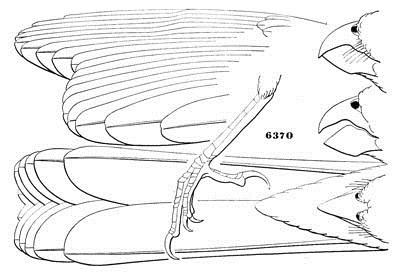
Pyrrhuloxia sinuata.
6370
Color. Gray, with red feathers and patches.
The essential character of this genus lies in the greatly curved, very short, and broad bill, something like that of Pyrrhula. In other respects like Cardinalis, but with less graduated wing, and longer and broader tail.
Pyrrhuloxia sinuata, BonapTEXAS CARDINALCardinalis sinuatus, Bp. Pr. Zoöl. Soc. Lond. V, 1837, 111 (Mexico).—Lawrence, Ann. N. Y. Lyc. V, 1851, 116.—Cassin, Illust. I, VII, 1854, 204, pl. xxxiii. Pyrrhuloxia sinuata, Bon. Consp. 1850, 500.—Baird, Birds N. Am. 1858, 508.—Heerm. X, c. 16.—Cooper, Orn. Cal. I, 236.
Sp. Char. Head with an elongated, pointed crest, springing from the crown. Upper parts generally pale ashy-brown; hood, sides of neck, and under parts of body, rather paler. Long crest-feathers, bill all round including lores and encircling the eye, wing and tail, dark crimson. Chin and upper part of throat, breast, and median line of the belly, under tail-coverts, tibia, edge and inner coverts of the wings, bright carmine-red. Bill yellowish. Length, about 8.50; wing, 3.75; tail, 4.50.
Female similar, with the under part brownish-yellow; middle of belly and throat only tinged with red.
Hab. Valley of the Rio Grande of Texas and westward; Cape St. Lucas; Mazatlan, Mexico.
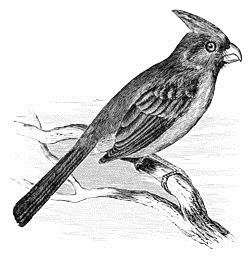
Pyrrhuloxia sinuata.
The wing is considerably rounded, the fourth and fifth quills longest; the first as long as the secondaries, the second longer than the seventh. The tail is long, graduated on the sides, the outer about half an inch shorter than the middle. The feathers are very broad to the end and obliquely truncate. They are rather broader than in Cardinalis virginianus. The crest is narrower and longer, and confined to the middle of the crown; it extends back about 1.80 inches from the base of the bill.
The carmine of the breast is somewhat hidden by grayish tips to the feathers; that of the throat is streaked a little with darker. The exposed surfaces of the wing-coverts and of secondaries and tertials are like the back. The tail-feathers are tipped with brownish.
Specimens from Cape St. Lucas are very much smaller than any others, measuring only, wing, 3.30; tail, 3.80. The crest is dull carmine, instead of dark wine-purple; the red tinge on wing and tail much fainter, and the sides, as well as the gray tints everywhere, more brownish; there is none of that dark burnt-carmine tint to the red of lores and cheeks observable in all the Texas specimens. No. 49,758, Camp Grant, Arizona, is like the Cape St. Lucas birds in colors, except that the crest is dusky, but the proportions are those of the Rio Grande series.
Habits. The Texan Cardinal was originally described as a bird of Mexico by Prince Charles Lucien Bonaparte in the Proceedings of the Zoölogical Society of London. It has since been ascertained to inhabit the southern central portions of our country, its range of extension northerly bringing it within the limits of the United States. In Texas, on the Rio Grande, it is resident throughout the year, or of but limited migration in the coldest weather. It was not observed by Dr. Coues in Arizona, but is said to occur in the southern portion of that Territory. It was found breeding at Cape St. Lucas by Mr. Xantus. It is not named by Sumichrast among the birds of Vera Cruz.
Its habits are said to be of the same general character with those of our common Cardinal.
The specimens from which this bird was first described were procured in the vicinity of the city of Mexico. The first obtained within the limits of the United States were observed by Captain McCown of the U. S. Army, at Ringgold Barracks, in Texas. Since then it has been procured by several of the naturalists accompanying the government expeditions. It was obtained in New Leon, Mexico, by Lieutenant Couch; in Texas, by Major Emory; in Texas and at El Paso, by Lieutenant Parke.
When first seen, in March, in the State of Tamaulipas, by Lieutenant Couch, it was in flocks, very shy and difficult of approach. It did not occur much in open fields, but seemed to prefer the vicinity of fences and bushes. It was often seen in company with the common Cardinal.
Dr. Kennerly found this bird quite abundant in the vicinity of El Paso, but did not observe it elsewhere. It kept generally in flocks of from three to six, frequenting the hedges and fruit-trees in the vicinity of houses. It became very restless when approached, flying from branch to branch and from tree to tree, uttering its peculiar note with great vehemence.
Dr. Heermann met with the first specimen of this bird in a dry cañon, a little to the east of the crossing of San Pedro River. It was perched on a bush, seemed wearied and lost, and was probably a wanderer. No more were seen until he reached El Paso. There he found it everywhere among the hedges and trees, and continued to meet with it occasionally on his road, until his party left civilization behind. It erects its crest as it moves actively about in search of food, and utters at intervals a clear, plaintive whistle, varied by a few detached notes.
Mr. Dresser considers this species rather a straggler from Mexico than as a Texan bird. Near Eagle Pass and Piedras Negras he found it abundant, but it became scarce as soon as he travelled a few miles into Texas. He saw none north or east of the Leona. He was told that quantities breed near Eagle Pass, and he saw not a few in cages that had been reared from the nest. He found it a shy bird, and difficult to shoot. When followed, it flies about uneasily, perching on the top of some high bush, and erecting its long crest, uttering a clear, plaintive whistle. Sometimes it would take to the thick brushwood and creep through the bushes so that it was impossible to get a shot at it. On the Lower Rio Grande it was of uncommon occurrence. He noticed a single pair near Matamoras in August, 1864.
Captain McCown, in his account of this species, published by Cassin, writes that, so far as seen on the Rio Grande, this handsome species appeared to have a strong partiality for damp and bushy woods. So far as he observed, it never ventured far from the river. He was under the impression that this bird remains in Texas all the year, having met with it so late in the fall and again so early in the spring, that, if not constantly resident, its migrations must be very limited. He describes it as a gay, sprightly bird, generally seen in company with others of the same species, frequently erecting its crest and calling to its mate or comrades. It is rather shy, and not easily approached. In its voice and general habits it appeared to him very similar to the common species.
The eggs of this species are of an oval shape, one end being only a little less rounded than the other. Their average measurement is one inch in length by .80 in breadth. Their ground-color is a dull chalky-white, over which are distributed well-defined blotches of a light umber-brown, and also a number of indistinct markings of purple. The spots are pretty uniform in these colors, but vary greatly in size and distribution. In some eggs they largely consist of fine dots, in others they are in bold blotches. In some the brown is more confluent and the effect that of a deeper shade.
Genus CARDINALIS, BonapCardinalis, Bonaparte, Saggio di una distribuzione metod. dei Animagli Vertebrati, 1831 (Agassiz). (Type, Loxia cardinalis, Linn.)
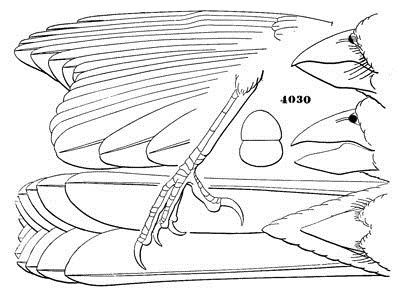
Cardinalis virginianus.
4030
Gen. Char. Bill enormously large; culmen very slightly curved, commissure sinuated; lower jaw broader than the length of the gonys, considerably wider than the upper jaw, about as deep as the latter. Tarsi longer than middle toe; outer toe rather the longer, reaching a little beyond the base of the middle one; hind toe not so long. Wings moderate, reaching over the basal third of the exposed part of the tail. Four outer quills graduated; the first equal to the secondaries. Tail long, decidedly longer than the wings, considerably graduated; feathers broad, truncated a little obliquely at the end, the corners rounded. Colors red. Head crested.
The essential characters of this genus are the crested head; very large and thick bill extending far back on the forehead, and only moderately curved above; tarsus longer than middle toe; much graduated wings, the first primary equal to the secondary quills; the long tail exceeding the wings, broad and much graduated at the end.




